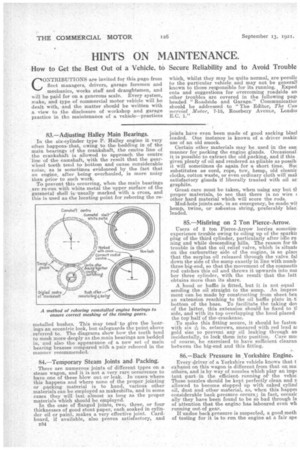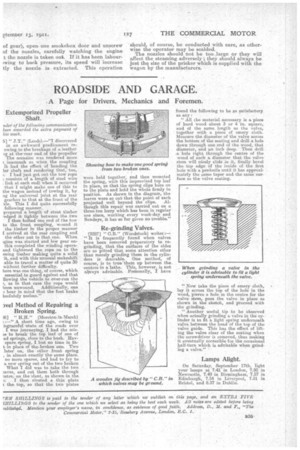HINTS ON MAINTENANCE.
Page 30

Page 31

If you've noticed an error in this article please click here to report it so we can fix it.
,How to Get the Best Out of a Vehicle, to
Secure Reliability and to Avoid Trouble
CONTRIBUTIONS are invited for this page from fleet managers, drivers, garage foremen and mechanics, works staff and draughtsmen, and mill be paid for on a generous scale. Every system, make, and type of commercial motor vehicle will be dealt with, and the matter should be written with a view to the disclosure of workshop and garage practice in the maintenance of a vehicle—practices which, whilst they may be quite normal, are peculiE to the particular vehicle and may not be general] known to those responsible for its running. Exped ents and suggestions for overcoming roadside an other troubles are covered in the following pagi headed "Roadside and Garage." (Jommunicatior should be addressed .-to "The Editor, The Con mereial Motor, 7-15, Rosebery Avenue, Londoi E.C. 1."
83.—Adjusting Halley Main Bearings. In the six-cylinder type P. Halley engine it very often happens that, owing to the bedding in of the main bearings of the crankshaft, the centre line of the crankshaft is allowed to approach the centre 'line of the camshaft, with the result that the gearwheel teeth tend to bottom and cause considerable noise, as is sometimes evidenced by the fact that an engine, after being overhauled, is more noisy than prior to such work. To prevent this occurring, when the main bearings are re-run with white metal the upper surface of the g-ursnetal shell is. usually marked with a cross, and this is used as the locating point for reboring the re metalled bushes. This may tend ' to give the bearings an eccentric look, but. safeguards the point above . referred to. The diagrams show how the teeth tend to mesh more deeply as themain bearings are bedded in, and also the appearance of a new set of main bearing brasses compared with a pair rebored in the manner recommended.'
84.—Temporary Steam Joints and Packing. . There are numerous joints of different types on a steam wagon and it is not a very rare occurrence to have one of ihese blow out or leak. In cases where this happens and where none of the proper jointing or packing material is to hand, various other materials can be employed as makeshifts, and in some cases they will last almost as long as the proper materials which should be employed. In the case of flanged joints, two, three, or four thicknesses of good stout paper, each soaked in cylinder oil or paint, makes a very effective joint. Card. board, if available,, also proves satisfactory, and B34 joints have even been made of good sacking bine] leaded. One instance is known of a driver ma-km use of an old smock. Certain other materials may be used in the can manner for packing the engine glands. Occasional: it is possible to extract the old packing, and if this, given plenty of oil and rendered as pliable as possib it will sometimes do again for a short time. Suc substitutes as cord, rope, tow, hemp, old cleanir cloths, cotton waste, or even ordinary cloth will satisfactory glands if liberally treated with oil at graphite. Great care must be taken, when using any but ti proper materials, to see that there is no wire 4 other hard material which will score the rods. Mud-hole joints can in an emergency, be made mil hemp, twine, or asbestos string, preferably brae. leaded.
85.—Misfiring on 2 Ton Pierce-Arrow.
Users of 2 ton Pierce-Arrow lorries sometim. experience trouble owing to oiling up of the sparkir plug of the third cylinder, particularly after idle ru ning and while descending hills. The reason for th trouble is that the oil relief valve, which is situat( on the carburetter side of the engine, is so plat that the surplus oil released through the valve, fal down the side of the sump exactly in line with numb three big-end, so that the movement of the connectii rod catches this oil and throws it upwards into nut ber three cylinder, with the result. that the latt obtains More than its share.
A hood or baffle is fitted, but it is not equal sending the oil straight to the sump. An improv ment can be made by constructing from sheet -bra an extension reaching to the oil baffle plate in-tl bottom of the base. To facilitate the taking dov of the latter, this extension should be fixed to V side, and with its top overlapping the hood placed the tap'half of theerankcase. To make this fitting secure, it should be fasten. with six 13-8in. setscrews, smeared with red lead ai Fold size to prevent any oil leaking through an incidentally, to lock theminto position. Care mm of course, be exercised to have sufficient clearan between the big-end and this fitting.
86.—Back Pressure in Yorkshire Engine. Every •driver of a Yorkshire vehicle knows that t exhaust on this wagon is different from that On ma others, and is by way of nozzle& which play an imp( tant part in the efficient. running of the vehic These nozzles should be kept perfectly clean and ii allowed to become stopped up with caked cylind oil, dust and other material, as, when this happei considerable back pressure occurs; in fact, occasic ally they have been found to be so bad through la of attention that the engine has laboured even wh running out. of gear. If undue back pressure is suspected, a good meth of testing for it is to run the engine at a fair spe of gear), openone smokebox door and unscrew of the nozzles, carefully watching the engine t the nozzle is taken out. If it has been labour'wing to back pressure, its speed will increase tly the nozzle is extracted. This operation should, of course, be conducted with care, as otherwise the operator may be scalded. The nozzles should not be too large or they will affect the steaming adversely ; they should always be just the size of the pricker which is supplied with the wagon by the manufacturers.
































